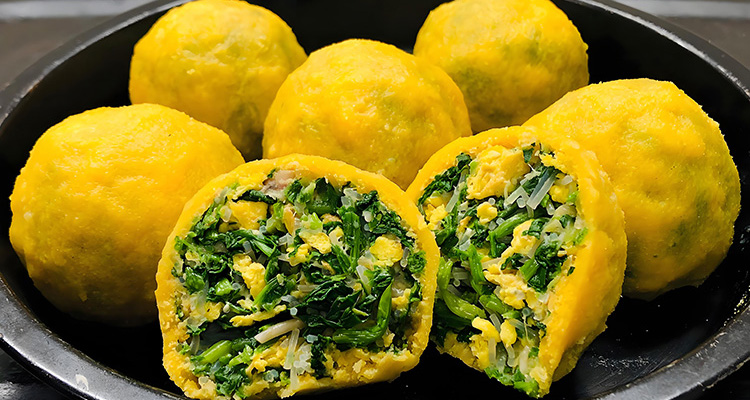Northeastern Vegetable Bun — A Taste of Warm Tradition
1. Origins And History
The Northeastern Vegetable Bun, or Dongbei Caituanzi, originated in rural Northeast China. Farmers first made it using local grains and vegetables as a hearty winter food. Over time, it became a beloved breakfast tradition, showing the clever ways Northeasterners adapted to the cold while creating flavorful, nourishing meals.
2. Cultural Meaning And Family Warmth
In the Northeast, this golden bun symbolizes family warmth and togetherness. It’s not just breakfast — it’s a shared experience. Families sit around steaming buns, chatting and laughing, enjoying the comforting aroma of fresh grains. It reflects the Dongbei philosophy that “coarse grains nourish both body and soul.” The Vegetable Bun represents hospitality, honesty, and the open-hearted nature of Northeastern people.

3. Ingredients And Regional Flavors
The beauty of the Northeastern Vegetable Bun lies in its simple ingredients. The outer layer is made from cornmeal, soy flour, or other grains, while the filling often includes cabbage, pork, pickled vegetables, wild greens, or tofu and mushrooms. These humble ingredients highlight the abundance of Northeast China, turning every bite into a blend of sweetness, saltiness, and earthy flavor.
4. How It’s Made
The process may be simple, but it requires care. The dough is kneaded until soft, then filled with seasoned vegetables or meat. Each bun is shaped into a round ball and steamed for 15–20 minutes. When done, the surface becomes glossy and chewy. This traditional steaming method preserves nutrients and brings out the authentic taste of Dongbei cuisine — rustic yet comforting.

5. Texture And Taste
The Vegetable Bun has a soft, chewy shell with a juicy, flavorful core. The grains bring mild sweetness, while the filling adds a savory punch. Together, they create a layered, homey flavor that feels like a warm hug on a cold morning. Every bite recalls the coziness of a Northeastern kitchen, filled with the scent of freshly steamed food.
6. How To Eat Like A Local
Locals prefer eating the bun by hand — simple and satisfying. Many dip it in soy sauce or spicy chili paste to enhance the taste. Pair it with a bowl of millet porridge or soy milk, and you’ll enjoy a classic Dongbei-style breakfast that’s balanced, filling, and easy to love.

7. Where To Try It
If you visit Northeast China, you’ll find the Northeastern Vegetable Bun in morning markets and small eateries. Great spots include Harbin’s Central Street Market, Shenyang’s Old Town, and Changchun’s snack stalls. Prices range from 10–20 RMB ($1–$3). Just say, “Two vegetable buns, please,” and watch them steam fresh before your eyes — a true street food experience.
8. Travel Tips
The Northeastern Vegetable Bun tastes best fresh out of the steamer — soft, warm, and full of aroma. If you find a stall selling it alongside jianbing guozi (Chinese crepes), grab a few of both. It’s the perfect way to sample multiple Dongbei snacks in one delicious stop.

9. Make It At Home
Want to recreate the flavor at home? Mix cornmeal with water into a soft dough, fill it with stir-fried cabbage and pork, and steam for about 15 minutes. No steamer? Use a skillet to pan-fry until golden. Pair with a homemade dipping sauce for a crispy twist. It’s a simple way to bring the taste of Northeast China into your own kitchen.
10. A Cultural Bite Worth Trying
The Golden Northeastern Vegetable Bun is more than food — it’s a piece of Chinese rural heritage. Each bun tells a story of simplicity, resilience, and warmth. Add it to your travel food list and let this chewy, golden treat open a door to Northeast China’s snow-filled charm. It’s not just a breakfast — it’s a taste of home, wherever you are.


